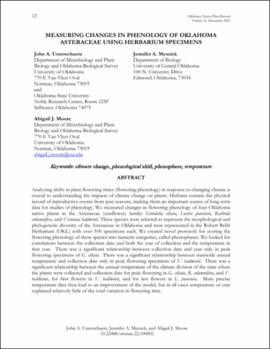| dc.contributor.author | Unterschuetz, John A. | |
| dc.contributor.author | Moore, Abigail J. | |
| dc.contributor.author | Messick, Jennifer A. | |
| dc.date.accessioned | 2023-02-16T00:18:20Z | |
| dc.date.available | 2023-02-16T00:18:20Z | |
| dc.date.issued | 2021 | |
| dc.identifier.citation | Unterschutez, J., Moore, A., & Messick, J. (2021). Measuring changes in phenology of Oklahoma asteraceae using herbarium specimens. Oklahoma Native Plant Record, 21. https://doi.org/10.22488/okstate.22.100002 | en_US |
| dc.identifier.uri | https://hdl.handle.net/11244/337028 | |
| dc.description.abstract | Analyzing shifts in plant flowering times (flowering phenology) in response to changing climate is crucial to understanding the impacts of climate change on plants. Herbaria contain the physical record of reproductive events from past seasons, making them an important source of long-term data for studies of phenology. We measured changes in flowering phenology of four Oklahoma native plants in the Asteraceae (sunflower) family: Grindelia ciliata, Liatris punctata, Ratibida columnifera, and Vernonia baldwinii. These species were selected to represent the morphological and phylogenetic diversity of the Asteraceae in Oklahoma and were represented in the Robert Bebb Herbarium (OKL) with over 100 specimens each. We created novel protocols for scoring the flowering phenology of these species into numeric categories, called phenophases. We looked for correlations between the collection date and both the year of collection and the temperature in that year. There was a significant relationship between collection date and year only in peak flowering specimens of G. ciliata. There was a significant relationship between statewide annual temperature and collection date only in peak flowering specimens of V. baldwinii. There was a significant relationship between the annual temperature of the climate division of the state where the plants were collected and collection date for peak flowering in G. ciliata, R. columnifera, and V. baldwinii, for first flowers in V. baldwinii, and for last flowers in L. punctata. More precise temperature data thus lead to an improvement of the model, but in all cases temperature or year explained relatively little of the total variation in flowering time. | en_US |
| dc.description.sponsorship | The authors thank the MPBIO department at the University of Oklahoma for supporting John Unterschuetz with the George L. and Cleo Cross Endowed Scholarship as an undergraduate student researcher during this investigation. | en_US |
| dc.language | en_US | en_US |
| dc.relation.uri | https://shareok.org/handle/11244/336289 | en_US |
| dc.rights | Attribution-NonCommercial-ShareAlike 4.0 International | * |
| dc.rights.uri | https://creativecommons.org/licenses/by-nc-sa/4.0/ | * |
| dc.subject | climate change | en_US |
| dc.subject | phenological shift | en_US |
| dc.subject | phenophase | en_US |
| dc.subject | temperature | en_US |
| dc.title | Measuring Changes in Phenology of Oklahoma Asteraceae Using Herbarium Specimens | en_US |
| dc.type | Article | en_US |
| dc.description.peerreview | Yes | en_US |
| dc.identifier.doi | https://doi.org/10.22488/okstate.22.100002 | en_US |
| ou.group | Dodge Family College of Arts and Sciences::Department of Microbiology and Plant Biology | en_US |

